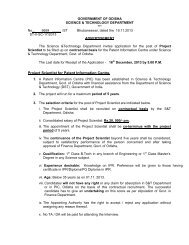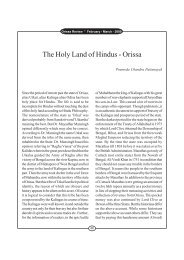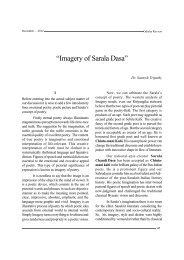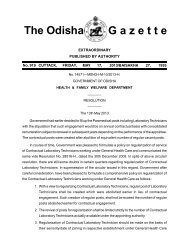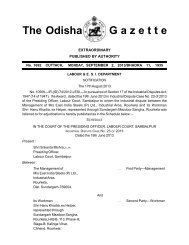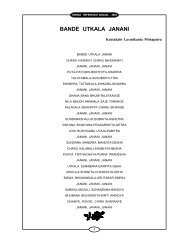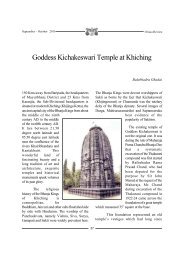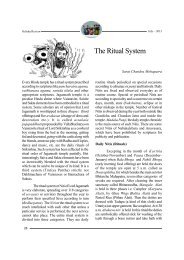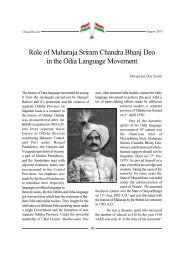Food Habits of the Tribal People During Scarcity Season
Food Habits of the Tribal People During Scarcity Season
Food Habits of the Tribal People During Scarcity Season
Create successful ePaper yourself
Turn your PDF publications into a flip-book with our unique Google optimized e-Paper software.
Orissa Review * August - 2004<br />
To meet <strong>the</strong> daily requirement <strong>of</strong> food people<br />
belonging to tribal groups <strong>of</strong> Ganjam district<br />
consume cheaply available food during<br />
scarcity season for <strong>the</strong>ir livelihood. Tapioca<br />
and sweet potato, usually harvested in <strong>the</strong><br />
months <strong>of</strong> November and December are<br />
available in <strong>the</strong> hilly areas. The scientific name<br />
<strong>of</strong> Tapioca is Manihat esculenta and Sweet<br />
Potato is Ipomoea batatas.<br />
Sweet Potato<br />
<strong>Food</strong> <strong>Habits</strong> <strong>of</strong> <strong>the</strong> <strong>Tribal</strong> <strong>People</strong> <strong>During</strong><br />
<strong>Scarcity</strong> <strong>Season</strong><br />
Scientific name - Ipomoea batatas<br />
Local name - Kandamula<br />
It is an important root and tuber, <strong>of</strong>ten<br />
eaten raw and also by boiling for 15-20<br />
minutes in water and is consumed with salt.<br />
Some times raw tubers are baked and roasted<br />
in fire for five minutes until brown colour is<br />
obtained and consumed after peeling. For<br />
32<br />
domestic consumption it can also be used in<br />
curry or in preparation <strong>of</strong> Chutney and sweet<br />
dish.<br />
Cassava Root or Tapioca<br />
Scientific name - Manihot esculenta<br />
Local name - Kathakanda<br />
Cassava roots are some times eaten raw<br />
usually in <strong>the</strong> first year <strong>of</strong> harvest. Freshly<br />
harvested after 8-10 months, <strong>the</strong>se nature root<br />
is soaked and boiled for 15 to 20 minutes and<br />
peeled and eaten with salt or sugar. Also<br />
soaked, <strong>the</strong> raw roots may be roasted by baking<br />
<strong>the</strong>m in fire for a few minutes till it gets <strong>the</strong><br />
brown colour. It may be eaten also with little<br />
salt. For domestic consumption it can also be<br />
used in <strong>the</strong> preparation <strong>of</strong> curry. It can be<br />
harvested after eight months <strong>of</strong> planting and<br />
stored for several weeks in a cool dry place.<br />
NUTRITIVE VALUE OF FOOD ITEMS PER 100 GMS OF WEIGHT<br />
(INDIAN COUNCIL OF MEDICAL RESEARCH PUBLICATION)<br />
Name <strong>of</strong> <strong>the</strong> food Carbohydrate Protein Fat Vitamins & Energy (K.Cal)<br />
(Gms.) (Gms.) (Gms.) Minerals (Mg.)<br />
1. Sweet Potato 28.2 1.2 0.3 6 mg. Carotene 120<br />
100 Gms. 0.08 Thiamine<br />
0.04 Rib<strong>of</strong>lavine<br />
0.07 Niacin<br />
24 mg. Vitamin C<br />
46 mg. Calcium<br />
50 Mg. Phosphorus<br />
0.8 Mg. Iron<br />
2. Tapioca 38.1 0.7 0.2 0.05 Thiamine 157<br />
100 gms. 0.10 Rib<strong>of</strong>lavine<br />
0.3 Niacin<br />
25 mg. Vitamin-C<br />
50 mg. Calcium<br />
40 mg. Phosphorus<br />
0.9 mg. Iron<br />
Dr. Saswati Parichha
Both <strong>the</strong> roots and tubers possess a large<br />
quantity <strong>of</strong> starch, least amount <strong>of</strong> protein, fat<br />
and sparing amount <strong>of</strong> Vitamin-C and minerals.<br />
These can be considered as a poor quality <strong>of</strong><br />
food. The root <strong>of</strong> Tapioca if kept unharvested<br />
for more than a year, it contains a poisonous<br />
substance. It is found in <strong>the</strong> outer peels <strong>of</strong> <strong>the</strong><br />
root which is normally peeled <strong>of</strong>f while<br />
cooking. The poisonous substance is bitter to<br />
taste and can be easily known. It should not be<br />
consumed as raw.<br />
Villagers <strong>of</strong> Ganjam district belonging<br />
to tribal groups consume dried seeds during<br />
lean period. Mango seed kernel, jack fruit seeds<br />
and ragi also serve <strong>the</strong>ir staple food.<br />
Jack Fruit Seeds<br />
After eating <strong>the</strong> juicy pulps <strong>of</strong> jack fruit<br />
<strong>the</strong>y collect <strong>the</strong> seeds, wash and dry <strong>the</strong>m under<br />
sunlight by indigeneous method and store it for<br />
future use. <strong>During</strong> scarcity season, <strong>the</strong>y boil it<br />
33<br />
Orissa Review * August - 2004<br />
in hot water, chop and mash it. Then <strong>the</strong>y salt<br />
to taste and consume it as <strong>the</strong>ir staple food.<br />
Ragi Porridge<br />
After collecting <strong>the</strong> ragi husk <strong>the</strong>y clean<br />
it, wash it and dry it in a wooden tray, under<br />
sunlight for 3 days. Then <strong>the</strong>y grind it and keep<br />
it in power form for future use. They make a<br />
porridge by putting powdered ragi to boiling<br />
water and storing constantly for 20 minutes.<br />
They add a little salt to taste. Some time <strong>the</strong>y<br />
also consume it with Pakhala (fermented rice<br />
water) and eat it after 12 hours (over night).<br />
Ragi Cake<br />
To boiling water <strong>the</strong>y add grinded power<br />
<strong>of</strong> ragi in proportion alongwith conconut<br />
grantes, ground nut pieces and jaggery and a<br />
little water. Then <strong>the</strong>y boil it in slow heat until<br />
it sets in a flat container, put a little oil or ghee<br />
at <strong>the</strong> bottom and top <strong>of</strong> <strong>the</strong> cake. After cutrting<br />
it into small pieces with a knife, <strong>the</strong>y eat it on<br />
festivals.<br />
NUTRITIVE VALUE OF THE FOODS PER 100 GMS OF DRY WEIGHT<br />
(SOURCE : INDIAN COUNCIL OF MEDICAL RESEARCH PUBLICATIONS)<br />
Name <strong>of</strong> <strong>the</strong> food Carbohydrate Protein Fat Vitamins & Energy (K.Cal)<br />
(Gms.) (Gms) (Gms) Minerals (Mg.)<br />
2. Jack Fruit Seeds 26 6.5 0.4 Calcium - 50 mg 133<br />
Phosphorus - 97 mg.<br />
Vitamin C- 11 mg.<br />
3. Ragi 72 7.3 1.0 Calcium 0. 344 mg 328<br />
Phosphorus - 283 mg.<br />
Iron - 6.4 mg.<br />
All <strong>the</strong> food stuffs are good source <strong>of</strong><br />
Carbohydrate.<br />
But Ragi and Jack Fruits contain good<br />
source <strong>of</strong> protein. Ragi is a rich source <strong>of</strong><br />
Calcium, Phosphorus and iron minerals, which<br />
keeps <strong>the</strong> body <strong>of</strong> pregnant, lactating women<br />
and young children healthy.<br />
Dr. Saswati Parichha is <strong>the</strong> Training Associate in Home<br />
Science, in <strong>the</strong> Direcrtorate <strong>of</strong> Extension Education<br />
in <strong>the</strong> Orissa Univesity <strong>of</strong> Agriculture and Technology,<br />
Bhubaneswar - 751003.



